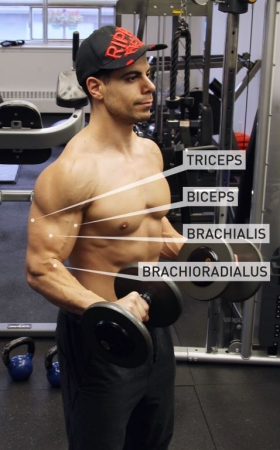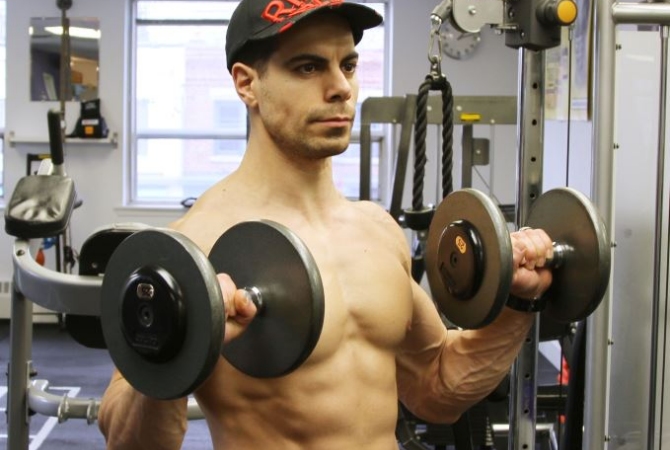01dragonslayer
Ripped
- Jacked Cash
- 485,556
Arm Anatomy 101
Your arms are the first part of your body that people notice. Ripped arms demand respect and prove your training and dedication to passers-by. That said, most are content with swinging barbell curls and half-ass tricep extensions - moves that are more about ego and less about building quality muscle. This article will give you an in-depth look at arm anatomy and reveal my 5 must-do exercises for arm growth and development.Biceps Brachii
The biceps brachii has several functions, the most important being to flex the elbow and rotate the forearm. The term biceps brachii is a Latin phrase meaning "two-headed (muscle) of the arm," and consists of two bundles each with its own origin, joining together at a point near the elbow. It is important to note that upper back exercises such as rowing and pulling movements will also incorporate the biceps brachii due to the elbow flexion required.
 Brachialis
Brachialis
The brachialis is a muscle in the upper arm that flexes the elbow joint. It lies just beneath the biceps brachii, and is a more powerful flexor of the elbow. Unlike the biceps, the brachialis does not insert on the radius, and therefore is not capable of pronation/supination of the forearm.
Brachioradialis
Brachioradialis is a forearm muscle that flexes the forearm at the elbow. It is also capable of both pronation and supination, depending on the position of the forearm. This muscle is highly visible in a flexed hammer curl position.Triceps Brachii
The triceps brachii muscle (Latin for "three-headed muscle of the arm”), is made up of three bundles of muscle, each of different origin, joining together at the elbow. The triceps make up approximately 60 percent of the upper arm's muscle mass.It is important to note that compound exercises involving elbow extension such as pressing movements and dips incorporate the triceps brachii. Close grip movements target the triceps more than wider grip movements.
| Muscle | Origin | Insertion | Function |
| Biceps Brachii Short Head | Coracoid process of scapula | Radial tuberosity | Flexes elbow and supinates the forearm |
| Biceps Brachii Long Head | Supraglenoid tubercle of scapula | Radial tuberosity | Flexes elbow and supinates the forearm |
| Brachialis | Anterior surface of Humerus (near insertion of deltoid) | Coronoid process and ulna | Flexes elbow |
| Brachioradialis | Lateral supracondylar ridge of humerus (lower part of humerus) | Distal Radius | Flexes and rotates elbow |
| Triceps Brachii Long Head | Infraglenoid tubercle of scapula | Olecranon process (elbow) | Extends forearm |
| Triceps Brachii Lateral Head | Posterior humerus | Olecranon process (elbow) | Extends forearm |
| Triceps Brachii Medial Head | Posterior humerus | Olecranon process (elbow) | Extends forearm |
Must-Do Arm Movements
Watch this video to see all exercises in action:Seated Lying Overhead Triceps Extension Combo
Why: To overload the triceps with 2 mass-building exercises back-to-back. This technique will provide different overhead angles to attack the triceps in one intense super set.Execution: Seated Overhead Triceps Extension (first 6-8 reps)
Sit on a bench, brace your core and hold a barbell overhead. Keep your elbows tight and slowly bend them to lower the barbell back and behind your head until you reach a 90 degree bend at the elbow joint. Contract the triceps as you lift the barbell back up to starting position, repeat 6-8 reps and move right into the lying triceps extension.Lying Overhead Triceps Extension (last 6-8 reps)
Lie on the bench and move the barbell back so it is over your forehead with your arms straight (starting position). Bend your elbows and resist the weight as you lower it down and over your forehead until you reach a 90 degree bend at the elbow joint.Tip: Keep your elbows locked in position and concentrate on only moving your forearms down and up during each rep to maximize triceps stimulation.
Overhead Kettlebell Triceps Extension
Why: To shock the triceps by offering a different challenge, with the weight hanging below the handle unlike with traditional dumbbells. This also improves functional power and grip strength, which is especially useful for sport specific conditioning.Execution: Stand with your feet shoulder-width apart and your knees slightly bent, brace your core and hold a kettlebell overhead with the weight hanging below the handle. With your elbows locked in position, slowly bend them to lower the kettlebell back and behind your head until you reach a 90 degree bend at the elbow joint. Contract the triceps as you push the kettlebell back up to starting position.
Variation: Try this with one kettlebell in each hand to target the triceps individually, which will recruit more stabilizers and require greater coordination/control.

Exercise Prescribed: V-Dip
Why: To use each repetition to focus on one tricep at a time by shifting your bodyweight to one side.Execution: Start at the top dip position with your arms fully extended and your body perpendicular to the floor. Lower yourself until your shoulders are lower than your elbows, or you feel a good stretch across the chest. Listen to your body and don't push through shoulder pain.
Push yourself up and completely to the left by extending your elbows to 180 degrees for a full range of motion. Lower yourself again to the bottom of the dip and this time; push yourself back up and to the right side.
Variation: Increase the challenge of this move by adding weight via chains or a belt.
Kettlebell Hammer Curls
Why: To engage the forearms, biceps and brachialis more than a basic dumbbell hammer curl. The kettle bell makes it harder to grip and perform each repetition.Execution: Grab a pair of kettle bells and stand with your feet shoulder-width apart and your knees slightly bent. Lock up your wrists and hammer curl the kettle bells by keeping your palms facing one another. Slowly resist the kettle bells back to starting position.
Tip: Keep your elbows tight to your sides and resist the temptation to move/raise them as you hammer curl the weight up.
Zottman Curls
Why: To take advantage of both the supinated and pronated grip in one movement. This allows you to target more muscles in the arm by combining elements of a regular and reverse curl.Execution: Grab a pair of dumbbells and stand with your feet shoulder-width apart and your knees slightly bent. Turn your palms up (supination) and move your dumbbell grip in towards the body. Curl the dumbbells up, pause at the top and reverse your grip (pronation) so your palms are now facing down. Lower the weight to full extension and reverse your grip back to a supinated position.
Tip: Select dumbbells that are about 50-60% of the weight you would normally use for standard curls in order to execute this exercise with proper technique.

